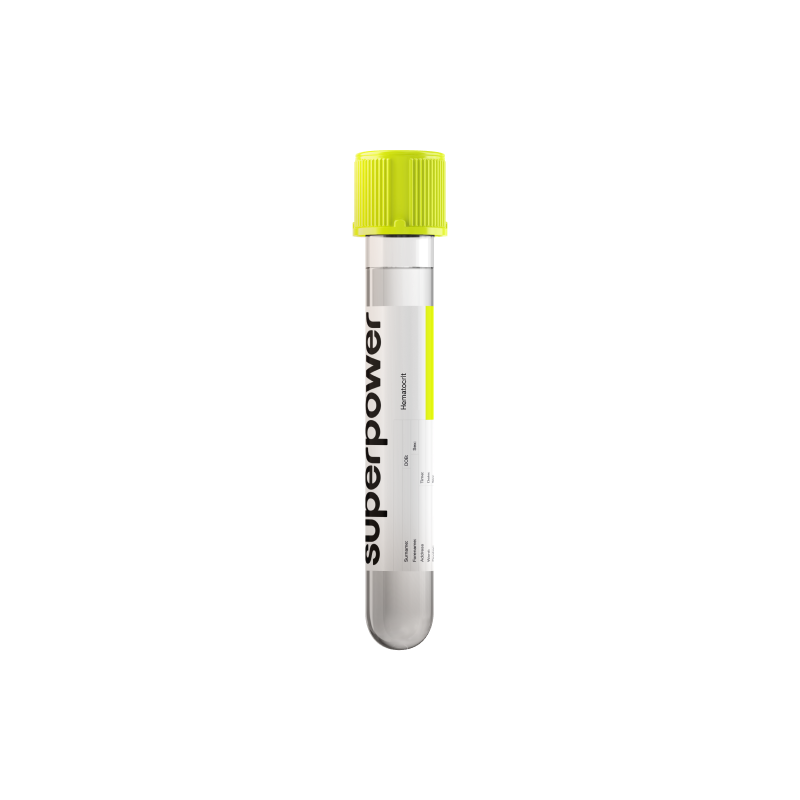Hematocrit is the proportion of your blood made up of red blood cells. It is reported as a percentage on a complete blood count (CBC) and is derived from automated analyzers. Hematocrit rises or falls with changes in red cell number, size, and plasma volume. Hydration, nutrient status (iron, B12, folate), kidney-produced erythropoietin, bone marrow health, testosterone exposure, altitude, and lung function all shape hematocrit.
Too low signals anemia and reduced oxygen delivery; too high increases viscosity and clot risk. Balanced hematocrit supports steady energy, clear cognition, and endurance. It is best interpreted alongside hemoglobin, red cell indices (MCV, MCH, MCHC, RDW), iron studies, vitamin B12, folate, and reticulocytes for a complete picture.
Key Benefits
- Measure red cell concentration to gauge your blood’s oxygen-carrying capacity.
- Spot anemia or polycythemia to explain fatigue, dizziness, or shortness of breath.
- Clarify dehydration or fluid overload, which can falsely raise or lower hematocrit.
- Guide next steps: iron studies, B12/folate testing, or adjusting testosterone therapy.
- Flag high hematocrit that raises blood viscosity, clot, and stroke risk.
- Support fertility by identifying iron-deficiency anemia that can impair ovulation and conception.
- Support pregnancy by detecting anemia tied to preterm birth and low birth weight.
- Track trends over time; best interpreted with hemoglobin, ferritin, and symptoms.
What is Hematocrit?
Hematocrit is the fraction of your blood that is made up of red blood cells (erythrocytes). It tells you how much of the total blood volume is occupied by these cells compared with the liquid portion (plasma). Red cells are produced in the bone marrow (hematopoiesis) under the signal of a kidney hormone called erythropoietin (EPO). Hematocrit is shaped by how many red cells you have and how large they are (red cell mass), as well as by the amount of plasma that carries them.
Hematocrit matters because red cells contain hemoglobin, the protein that binds oxygen, so this proportion reflects the blood’s overall oxygen-carrying capacity. It also influences how easily blood flows through vessels (viscosity): more cells relative to plasma make blood thicker, fewer make it thinner. In this way, hematocrit expresses the body’s balance between oxygen delivery and circulatory ease—linking oxygen needs, bone marrow output, and fluid regulation by the kidneys and vascular system.
Why is Hematocrit important?
Hematocrit is the proportion of your blood made up of red blood cells. It is a window into how well your body moves oxygen from lungs to tissues while keeping blood thin enough to flow easily. Because it reflects bone marrow output, kidney erythropoietin signaling, iron status, hydration, and lung-heart function, it integrates multiple systems at once.
Typical values sit in the mid-40s for adult men and high-30s to low-40s for adult women; children vary by age, newborns run higher, and pregnancy naturally trends lower from plasma expansion. For most people, the physiological “sweet spot” is the middle of the range, where oxygen delivery and blood viscosity are balanced.
When hematocrit runs low, there is less oxygen-carrying capacity per drop of blood. The heart and lungs compensate with faster rate and breathing, and tissues signal for more flow. Fatigue, shortness of breath, lightheadedness, pallor, cold hands, and reduced exercise tolerance can appear. Causes include blood loss, iron/B12/folate deficiency, chronic kidney disease (low erythropoietin), chronic inflammation, hemolysis, or marrow disorders. Women and menstruating teens tend to run lower; in pregnancy, lower hematocrit reflects hemodilution but true anemia adds maternal fatigue and can affect fetal growth.
When hematocrit is high, blood becomes more viscous. The heart works harder, and microcirculation slows, leading to headaches, flushing, blurred vision, and itching after warm showers. Triggers include altitude, lung or heart disease, sleep apnea, smoking, testosterone or erythropoietin use, dehydration, or primary marrow disease; in pregnancy, unusually high values may signal inadequate plasma expansion.
Big picture: hematocrit links oxygen transport with marrow health, iron metabolism, kidneys, lungs, and the cardiovascular system. Persistently low levels relate to diminished capacity and cardiac strain; persistently high levels increase clot, stroke, and heart attack risk.
What Insights Will I Get?
Hematocrit measures the proportion of your blood made up by red blood cells. It is a direct read on oxygen-carrying capacity, blood viscosity, and the workload on the heart and vessels. Because oxygen delivery underpins energy metabolism, cognition, temperature regulation, and tissue repair, hematocrit is a systems-level signal of whole‑body resilience.
Low values usually reflect too few red cells or too much plasma volume (anemia or hemodilution). This reduces oxygen delivery, showing up as fatigue, breathlessness, poor exercise tolerance, headaches, and trouble concentrating. Common physiologic contexts include iron or vitamin shortfalls, chronic inflammation, kidney underproduction of erythropoietin, blood loss, or pregnancy-related plasma expansion. Reference ranges are lower in women and during pregnancy, and low values can be more symptomatic in older adults.
Being in range suggests adequate oxygen transport, healthy bone marrow output, sufficient iron stores, and balanced plasma volume. It also implies coordinated kidney–erythropoietin signaling and thyroid–adrenal support of red cell production. For most adults, optimal sits near the middle of the sex-specific reference range, where oxygen delivery is robust without excess blood thickness.
High values usually reflect more red cells or less plasma volume (erythrocytosis or hemoconcentration). This thickens blood, increasing vascular resistance and the risk of headaches, flushing, high blood pressure, and clots. Common drivers include chronic low oxygen (altitude, lung disease, sleep apnea), smoking, androgen exposure, or a myeloproliferative process such as polycythemia vera.
Notes: Interpretation shifts with altitude, hydration, recent illness, menstruation, and pregnancy. Athletes may run lower from plasma expansion. Values differ by age and sex. Certain medications (androgens, erythropoiesis-stimulating agents, chemotherapy) and sampling posture can alter results.



.svg)



.png)
.png)
.png)
.png)








